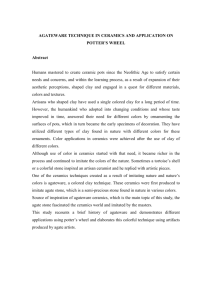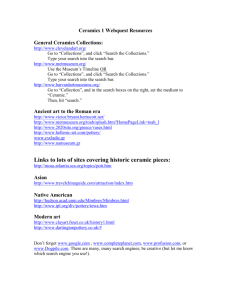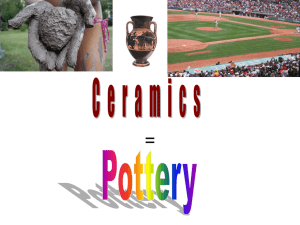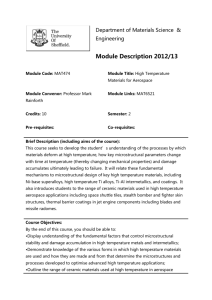maya ceramicas wiki - ucfant3145f09-07
advertisement
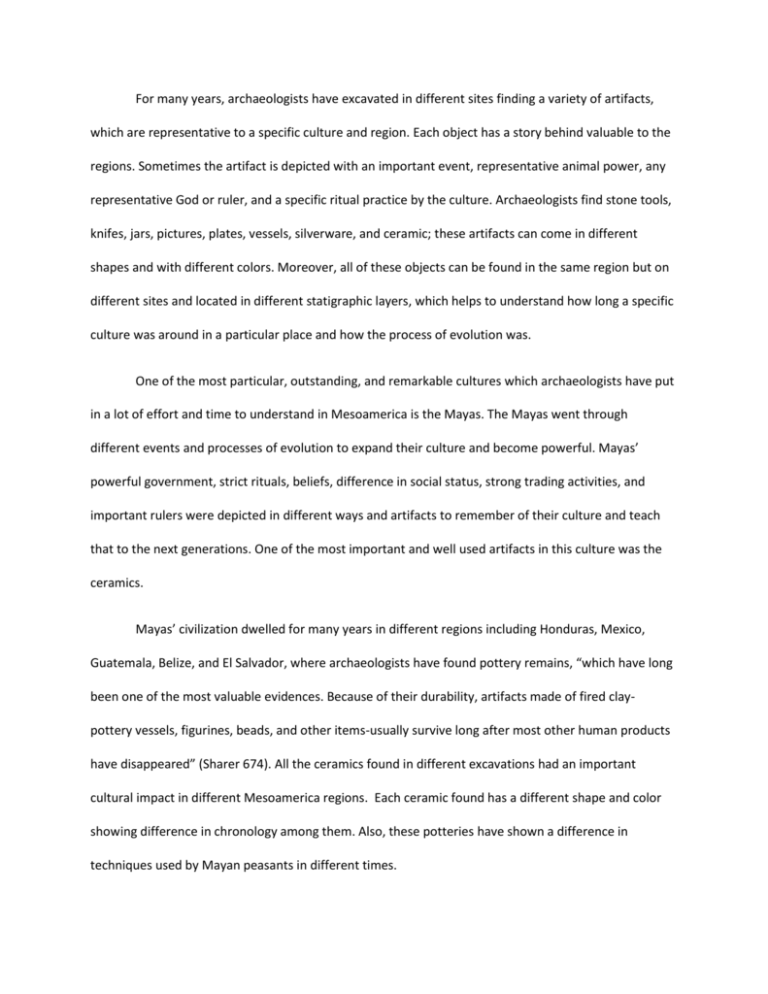
For many years, archaeologists have excavated in different sites finding a variety of artifacts, which are representative to a specific culture and region. Each object has a story behind valuable to the regions. Sometimes the artifact is depicted with an important event, representative animal power, any representative God or ruler, and a specific ritual practice by the culture. Archaeologists find stone tools, knifes, jars, pictures, plates, vessels, silverware, and ceramic; these artifacts can come in different shapes and with different colors. Moreover, all of these objects can be found in the same region but on different sites and located in different statigraphic layers, which helps to understand how long a specific culture was around in a particular place and how the process of evolution was. One of the most particular, outstanding, and remarkable cultures which archaeologists have put in a lot of effort and time to understand in Mesoamerica is the Mayas. The Mayas went through different events and processes of evolution to expand their culture and become powerful. Mayas’ powerful government, strict rituals, beliefs, difference in social status, strong trading activities, and important rulers were depicted in different ways and artifacts to remember of their culture and teach that to the next generations. One of the most important and well used artifacts in this culture was the ceramics. Mayas’ civilization dwelled for many years in different regions including Honduras, Mexico, Guatemala, Belize, and El Salvador, where archaeologists have found pottery remains, “which have long been one of the most valuable evidences. Because of their durability, artifacts made of fired claypottery vessels, figurines, beads, and other items-usually survive long after most other human products have disappeared” (Sharer 674). All the ceramics found in different excavations had an important cultural impact in different Mesoamerica regions. Each ceramic found has a different shape and color showing difference in chronology among them. Also, these potteries have shown a difference in techniques used by Mayan peasants in different times. Not only were ceramics made by Mayas to depict important rituals, events, and rulers, but also were made with the purpose of storage, cooking, eating, or to please the gods with offerings. Pottery helped archaeologists to understand and to show “the way people lived, social differences between classes, and long-vanished economic systems”( Culbert 71). All of these purposes lead Mayas to change their way of crafting pottery, making them different every time the necessities and times changed, which was reflected between time periods. The three time periods where ceramics changed so significantly are preclassic, classic, and postclassic. The preclassic Period was about 2000 B.C-A.D 250. It was the earliest period in the Mayan Civilization. As was stated by Patrick Culbert, new types of pottery were revealed in the site of Cuello in Belize that comprised what is called the Swasey. This type of “pottery was not given to exuberant decoration. Unslipped vessels, along with predominately red and orange slipped wares, and a few pieces are incised with simple geometric patterns or painted with red-on-cream decorations”(Culbert 73). Swasey was the first simple and primitive technique used by the Mayas, which dates back as far as 2500 B.C, to the beginning of its civilization, they were found in a few sites of Belize. Archaeologists found another type of ceramic technique later in this period, which these were not much as significant as swasey, such as Xe and Eb. These ceramics were found along the sites of Rio Pasion in the southern lowlands and in the central lowlands, and were characterized by the simplicity used by Mayan crafters. Stated by Sharer, they were simple vessels because the neckless jar forms were not often used for the transport of water and food products (Sharer 679). Not only were these different types of ceramics found during the preclassic time period, but also the Mamom ceramics were found. This pottery is dated around 1000- 800 A.C, which is founded in the middle preclassic. This type of pottery has come from Yucatan to the highland showing a widespread growth of the culture, during this middle preclassic period. Mamom ceramics were characterized by the flat-bottomed plates, round-side bowls and open-mouthed jars and they were not crafted as simple as the swasey ceramics. For example, Culbert explained how these ceramics had one or two lines encircling the lips of plates or more rarely, a row of triangles or a checkerboard motif. Also, Mamom showed the first attempt and evidence of using colors of red-on-cream and red-on-orange calling this type of technique “bichrome”. After the Mamom ceramics the Chicanel pottery came playing a different role in this civilization. Chicanel were dated from 300 B.C to A.D 250 and excavated from some sites of Providencia/Miraflores in the highlands and others from the lowlands. “These ceramics had become even more elaborate and innovative, in both forms and decorations” (Sharer 682). Chicanel used different types of colors showing the variety on the design. The decorating technique of the use of Black-brown, lustrous-red, orange, and cream was named “Usulutan”, which were predominately used on the bowls and plates with shelflike flanges. This style was characterized by painting over a first slip with a material such as wax that would prevent the adherence of a second or third slip. Stated by Culbert these colors were used with the idea of creating wavy or zigzag patterns of parallel lines. The difference in the use of colors and shapes, during this period, has shown an improvement whether in the way of living or in way of expanding their culture. Right after the preclassic time period got to the end, this civilization went into a new phase of ceramic improvements and decorating when the classic period started. This period was divided into early, late, and terminal classic, which each stage was unique in the production of ceramics. Starting with a general idea of crafting ceramics in the classic period, ceramics were characterized by the use of multiple colors and texts engraved on them. These hieroglyphic texts were remarkably situated in the upper rim of the vessel, but sometimes, “these texts were found in the lower rim indicating religious ideology, cosmology, and representations of supernatural to depictions of both the public, and private rituals that comprised elite Maya life and history”(Reents-Budet). Also, in this period Dorie Reents-Budet exposed that the primary characteristic that survives in the ceramics was the pictorial polycrhrome, which was created as part of the increasingly complex social, political and economic developments. Decorating these vessels severed as an important role as social currency within the realm of elite gift exchange but also, these vessels ended up in the burials of pre-Columbian era. However, there were three stages of this period, which had different techniques and designs on ceramics. The first period of the classic was the early period, which was about 250 A.D-550 A.D. Most of the majority of ceramics were found in the lowlands and were different by the use of multiple colors, bright orange colors, and the used of text engrave on them. The design applied in this period was called Tzacol which were the production of cylindrical vessel with a tripod support in the base showing a polychrome paint, stucco, and beautiful gouged-incised relief motifs with a geometric pattern on them. They were found commonly in the area of Teotihuacan. Adding color to the Tzakol ceramic was easier thanks to the use of high temperature at the time of making the item with clay. Moreover, the common colors used in the early period were red and black after been painted the based with orange or cream colors. Using this new technique of Tzakol, the walls of the ceramics were thinner, the neck of jars became taller and more delicate, and small bowls and dishes were increasingly common. On the other hand, the late period was about 550 A.D- 800 A.D showed the variety of reciprocal activities occurred in diverse regions in the lowlands during this period. These ceramics were “transformed into a prime medium on whose surfaces were created great paintings. These paintings on ceramic represent many different artistic styles and record detailed images of Maya history and religion”(Reents-Budet 72). Mayans to accomplish a defined draw for decorating their ceramics used paintbrush leading to have a well describe and depicted story of any type; such as social events, myths, or rituals. Not only were these ceramics depicted the social event but also were they having a particular and unique hieroglyphically text called Codex-style crafted in the northeast-central of Peten department, nearby the archaeological sites of Pacaya and El Mirador. This is explained by Dorie ReentsBudet as the presence of red strips on the edges and pictorial images in different and variety ceramic size especially small; for example low- small cylindrical cups and small vessels. However, it was another symbolic type exposed by Dr. Reents-Budet called Plates with “danzantes”, which had an iconographic program well defined produced in Tikal and Uaxactum. During this period were two ceramics styles found in Holmul which were Tepeu 1 and Tepeu 2. Tepeu 1 were located 25 Km south of Holmul and characterized “by the red-and-orange-on-cream palette (Saxche Orange Polycrome) with small amounts of a opaque black slip highlighting parts of the imagery and a restricted number of specific iconographic themes” (Dorie Reents-Budet). These ceramics were round-sided bowls and large tripod plates, which were decorated with a row of glyphs or pseudoglyphs, delimited at the tip and bottom by contrasting lines of color. Also, they were decorated with human or demon head, flowers, or an animal. On the other hand, Tepeu 2 was founded in the eastern Guatemala, which was characterized by using brighter colors and busier designs; for instance, the colors were called zacatel cream and palmar orange polychrome, which were used on the ceramics in checkerboards, diamonds, dots within circles, sausages-like semicircular brackets designs. All of these were found typically on tall cylinders vessels, small flaring-sided bowls, and large flaring-sided tripod plates. The terminal period was about 800 A.D-1000 A.D characterized by reducing pottery production, but the polychrome style changed. “Mayans pottery was technically well done, so that the domestic vessels, which can be distinguished from earlier ones by minor changes in shape”(Culbert 81). These minor changes were noticed by the use of the fine orange polychrome, hard fired, thin walled, and with a variety of simple elegant shapes. Also, these ceramics were made with militarism themes and scenes showing conferences between individuals trading products. these fine orange ceramics were found in a widely Mayan area such as Tabasco. Mayans went into the final period of ceramic evolution called Postclassic period divided in two; early and late. During the early postclassic time strong regional differences between north and south of the lowland region were happening. North had a vigorous regional growth while south region was decreasing on population and on pottery production. Nevertheless, the pottery of this time was characterized by fired in enclosed pit Kilns, which reach a high temperature for vitrificating and the used of the plumbate ware “the only true vitrified (glazed) pottery in pre-Columbian America, which was produced along the Pacific piedmont in South-western Guatemala”(Sharer 702). Also, Mayans were decorating these ceramics by molding and carving human and animal effigies. However, the pottery of the late postclassic was characterized by different things. These types of pottery were found in a “variety of sites of the eastern coast of the Peninsula to thriving centers such as Tulum, Santa Rita, and Lamani” (Culbert 83). Not only were found in different sites of the Highland Maya but also were ceramics tempered with volcanic ash with a common shape of necked jars, bowls with plain or tripod support depicted with bands, circles, dots, triangles, and diamonds. They were colored with a red and cinnamon ware. The production of the different ceramics during these three remarkable and unique periods was a great help to understand their history and evolution process. Mayans exposed their evolution through colors, techniques, designs, and different shapes on the pottery; found in different regions and sites. But, they showed the strong trading activity among regions of the highlands and lowlands and showed the difference on social and economic status in each period. Ceramics were great resources to study and to understand the Mayans civilization and their evolution.



